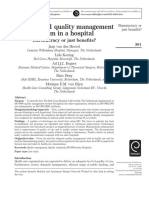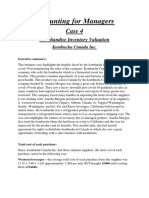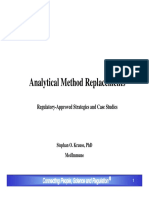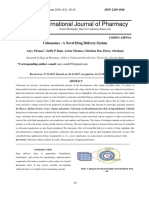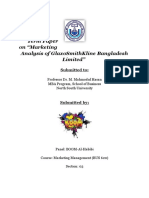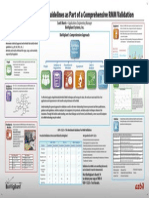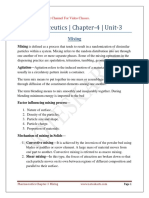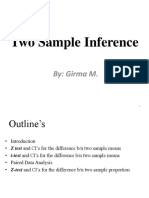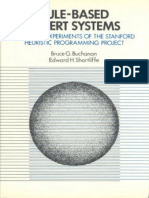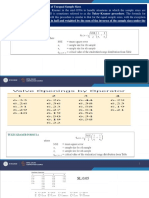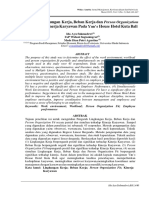Layout of the test of significance
Test for Means and Proportions
Small Large
sample sample
Population Population Population Population
variance variance variance variance
known not known known not known
Z-test t-test Z-test t-test
Testing of means and proportion for one sample
Example:
A sample of 12 jars of peanut butter was taken from a lot, each jar being labeled “
8 ounces net weight.” The individual weights in ounces are: 8.2, 8.0, 7.6, 7.7, 7.5, 7.3,
7.4, 7.5, 8.0, 7.4, 7.5. Test whether these values are consistent with a population mean of
8. Assume that the weights are normally distributed. Use SPSS software and interpret the
results.
Results:
T-Test
One-Sample Statistics
N Mean Std. Deviation Std. Error Mean
weights in ounces 12 7.642 .2811 .0811
One-Sample Test
Test Value = .05
95% Confidence Interval of the
Difference
t Df Sig. (2-tailed) Mean Difference Lower Upper
weights in ounces 93.556 11 .000 7.5917 7.413 7.770
Example:
A manufacturer claims that his light bulbs have an average lifetime of 1500 hours.
A purchaser decides to check this claim and finds that for six bulbs the lifetimes are 1472,
1486, 1401, 1350, 1610, 1590 hours. Does this evidence support the manufacturer’s
claim? Assume that the lifetime of the light bulbs are normally distributed.
Results
T-Test
One-Sample Statistics
N Mean Std. Deviation Std. Error Mean
bulbs life times hours 6 1484.83 102.079 41.674
One-Sample Test
Test Value = 0.05
95% Confidence Interval of the
Difference
t Df Sig. (2-tailed) Mean Difference Lower Upper
bulbs life times hours 35.629 5 .000 1484.783 1377.66 1591.91
Testing of means and proportion for two sample
Two Independent groups
Example:
Two independent groups, each of 10 children, were tested in General Knowledge.
Their scores were as follows:
Group A: 7, 7,6,7,9,6,8,6,6,10
Group B: 6,6,4,7,8,6,6,5,6,8
Is the difference between mean scores of the two groups significant?
T-Test
Group Statistics
Group N Mean Std. Deviation Std. Error Mean
score Groupa 10 7.20 1.398 .442
Groupb 10 6.20 1.229 .389
Independent Samples Test
Levene's Test for
Equality of
t-test for Equality of Means
Variances
95% Confidence
Mean Std. Error Interval of the
F Sig. t df Sig. (2-tailed)
Difference Difference Difference
Lower Upper
Equal
variances .305 .587 1.698 18 .107 1.000 0.589 -.237 2.237
assumed
cases Equal
variances
not
1.698 18 .107 1.000 0.589 -2.37 2.237
assumed
Matched or Paired Groups
The weights of 4 persons before they stopped smoking and 5 weeks after they
stopped smoking are as follows:
Person 1 2 3 4
Before 148 176 153 116
After 154 176 151 121
Use the t-test for paired observations to test the hypothesis that giving up smoking has no
effect on a person’s weight.
T-Test
Paired Samples Statistics
Mean N Std. Deviation Std. Error Mean
Pair 1 after weight 150.50 4 22.605 11.303
before weight 148.25 4 24.717 12.358
Paired Samples Correlations
N Correlation Sig.
Pair 1 after weight & before weight 4 .991 .009
Paired Samples Test
Paired Differences
Std. Std. Error sig (2-
Mean Deviation Mean t df tailed)
Pair after weight - before 2.250 3.862 1.931 1.165 3 .328
1 weight
More than two samples
One way analysis of variance (ANOVA):
Example:
Two following are three consecutive weeks’ earnings of three salesmen employed
by a given firm:
Salesmen
A B C
152 181 160
175 171 130
124
180 203
Whether differences between salesmen are significant.
Results:
One-way
ANOVA
salesmen
Sum of Squares df Mean Square F Sig.
Between Groups 3426.000 2 1713.000 5.955 .038
Within Groups 1726.000 6 287.667
Total 5152.000 8
Post Hoc Tests
Multiple Comparisons
salesmen
LSD
95% Confidence Interval
Mean Difference
(I) group (J) group (I-J) Std. Error Sig. Lower Bound Upper Bound
salesmen A salesmen B -16.000 13.848 .292 -49.89 17.89
salesmen C 31.000 13.848 .066 -2.89 64.89
salesmen B salesmen A 16.000 13.848 .292 -17.89 49.89
salesmen C 47.000* 13.848 .015 13.11 80.89
salesmen C salesmen A -31.000 13.848 .066 -64.89 2.89
salesmen B -47.000* 13.848 .015 -80.89 -13.11
*. The mean difference is significant at the 0.05 level.
ANOVA - Two way classification
The two way classification is a mere extension of the one-way ANOVA. You will
have two factors for which the population means will have to be compared.
Example:
A supermarket that has a chain of stores is concerned about its service quality
reputation perceived by its customers. The table below shows the perceived services
quality with regard to politeness of the staff. The number in each cell of the table is the
percentage of people who have said that the staff is polite. Perform the two-way ANOVA
and draw your inference about the population means of politeness corresponding to the
days, as well as, the stores.
Day/ Store A B C D E
Monday 79 81 74 77 66
Tuesday 78 86 89 97 86
Wednesday 81 87 84 94 82
Thursday 80 83 81 88 83
Friday 70 74 77 89 68
Results:
Univariate Analysis of Variance
Tests of Between-Subjects Effects
Dependent Variable:percentage of people
Type II Sum of
Source Squares df Mean Square F Sig.
day Hypothesis 617.360 4 154.340 8.737 .001
Error 282.640 16 17.665a
store Hypothesis 461.760 4 115.440 6.535 .003
Error 282.640 16 17.665a
a. MS(Error)
Post Hoc Tests
day
Multiple Comparisons
percentage of people
LSD
95% Confidence Interval
Mean Difference
(I) day (J) day (I-J) Std. Error Sig. Lower Bound Upper Bound
monday tuesday -11.80* 2.658 .000 -17.44 -6.16
wednesday -10.20* 2.658 .001 -15.84 -4.56
thursday -7.60* 2.658 .011 -13.24 -1.96
friday -.20 2.658 .941 -5.84 5.44
tuesday monday 11.80* 2.658 .000 6.16 17.44
wednesday 1.60 2.658 .556 -4.04 7.24
thursday 4.20 2.658 .134 -1.44 9.84
friday 11.60* 2.658 .000 5.96 17.24
wednesday monday 10.20* 2.658 .001 4.56 15.84
tuesday -1.60 2.658 .556 -7.24 4.04
thursday 2.60 2.658 .343 -3.04 8.24
friday 10.00* 2.658 .002 4.36 15.64
thursday monday 7.60* 2.658 .011 1.96 13.24
tuesday -4.20 2.658 .134 -9.84 1.44
wednesday -2.60 2.658 .343 -8.24 3.04
friday 7.40* 2.658 .013 1.76 13.04
friday monday .20 2.658 .941 -5.44 5.84
tuesday -11.60* 2.658 .000 -17.24 -5.96
wednesday -10.00* 2.658 .002 -15.64 -4.36
thursday -7.40* 2.658 .013 -13.04 -1.76
Based on observed means.
The error term is Mean Square(Error) = 17.665.
*. The mean difference is significant at the 0.05 level.
Post Hoc Tests
store
Multiple Comparisons
percentage of people
LSD
95% Confidence Interval
Mean Difference
(I) store (J) store (I-J) Std. Error Sig. Lower Bound Upper Bound
store A store b -4.60 2.658 .103 -10.24 1.04
store c -3.40 2.658 .219 -9.04 2.24
store d -11.40* 2.658 .001 -17.04 -5.76
store e .60 2.658 .824 -5.04 6.24
store b store A 4.60 2.658 .103 -1.04 10.24
store c 1.20 2.658 .658 -4.44 6.84
store d -6.80* 2.658 .021 -12.44 -1.16
store e 5.20 2.658 .068 -.44 10.84
store c store A 3.40 2.658 .219 -2.24 9.04
store b -1.20 2.658 .658 -6.84 4.44
store d -8.00* 2.658 .008 -13.64 -2.36
store e 4.00 2.658 .152 -1.64 9.64
store d store A 11.40* 2.658 .001 5.76 17.04
store b 6.80* 2.658 .021 1.16 12.44
store c 8.00* 2.658 .008 2.36 13.64
store e 12.00* 2.658 .000 6.36 17.64
store e store A -.60 2.658 .824 -6.24 5.04
store b -5.20 2.658 .068 -10.84 .44
store c -4.00 2.658 .152 -9.64 1.64
store d -12.00* 2.658 .000 -17.64 -6.36
Based on observed means.
The error term is Mean Square(Error) = 17.665.
*. The mean difference is significant at the 0.05 level.
Example:
A certain company had four salesmen A,B,C and D each of whom was sent for a
week into three types of area, country area K, outskirts of a city O and shopping centre of
a city S. The sales in pounds per week are shown below:
Salesmen
District
A B C D
K
30 70 30 30
O
80 50 40 70
S
100 60 80 80
Carry out analyses of variance and interpret the results stating the assumptions under
which your results are valid.
Results:
Two-way ANOVA
Tests of Between-Subjects Effects
Dependent Variable:sales
Type II Sum of
Source Squares df Mean Square F Sig.
salemen Hypothesis 600.000 3 200.000 .500 .696
Error 2400.000 6 400.000a
district Hypothesis 3200.000 2 1600.000 4.000 .079
Error 2400.000 6 400.000a
a. MS(Error)












